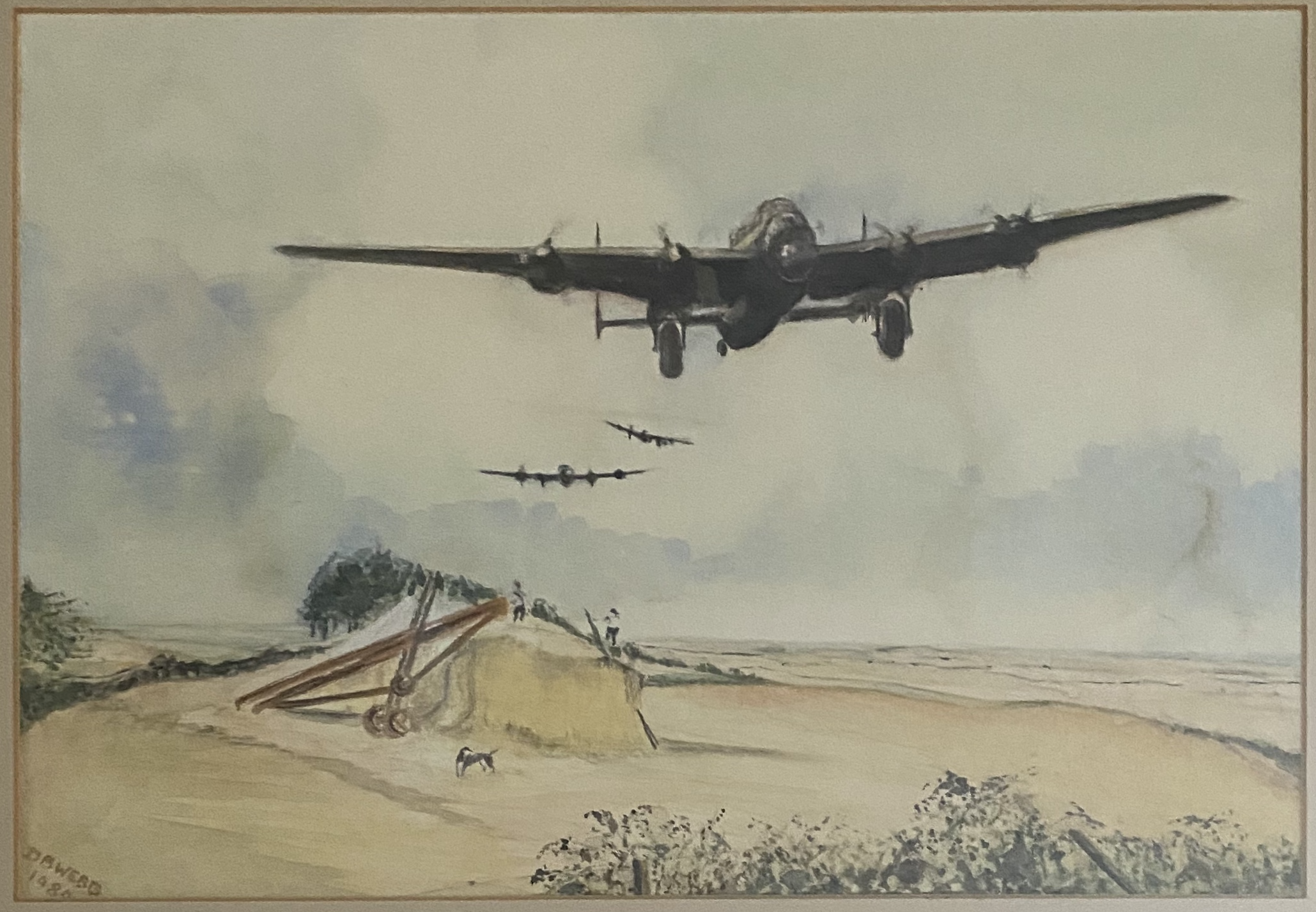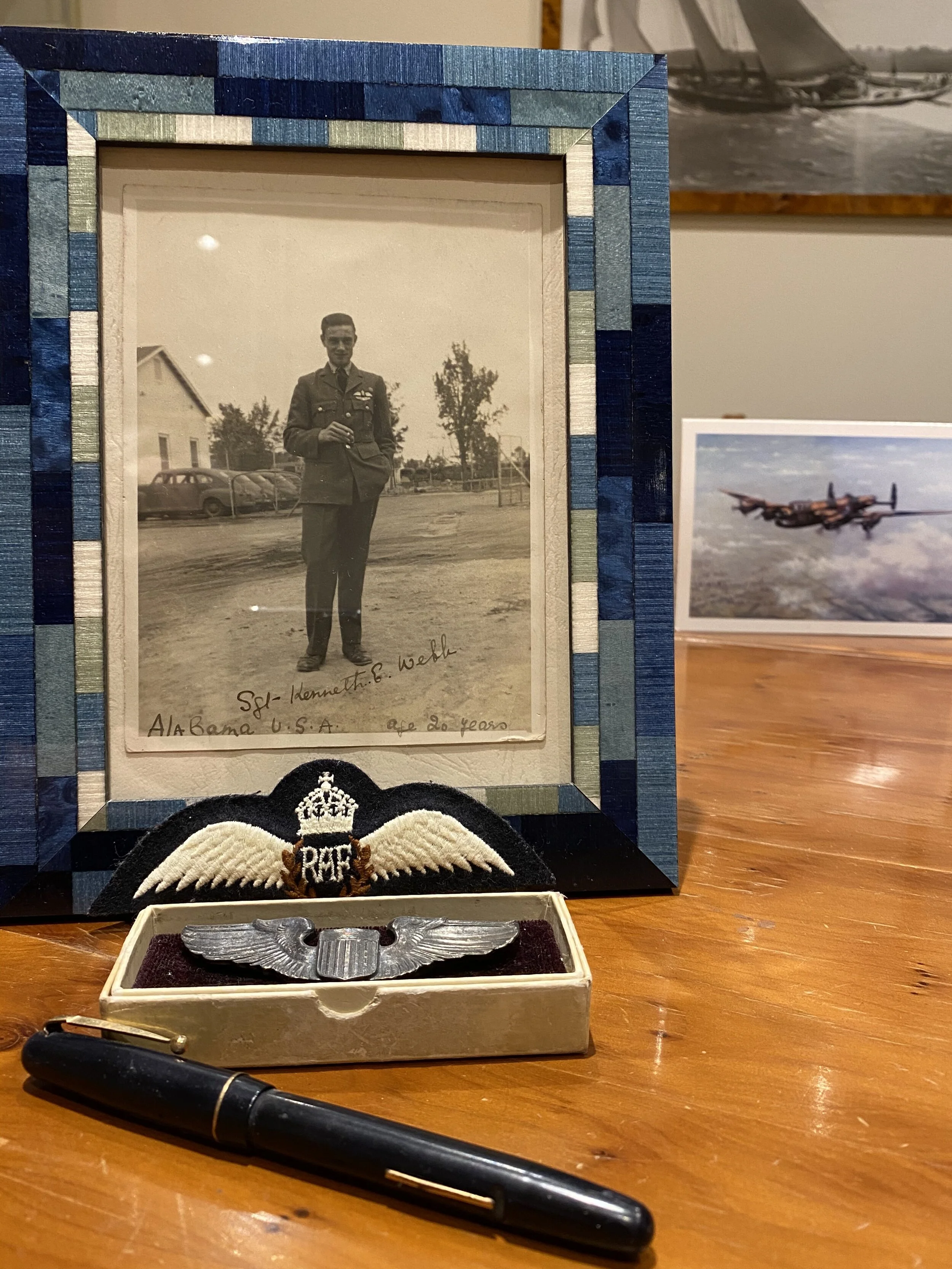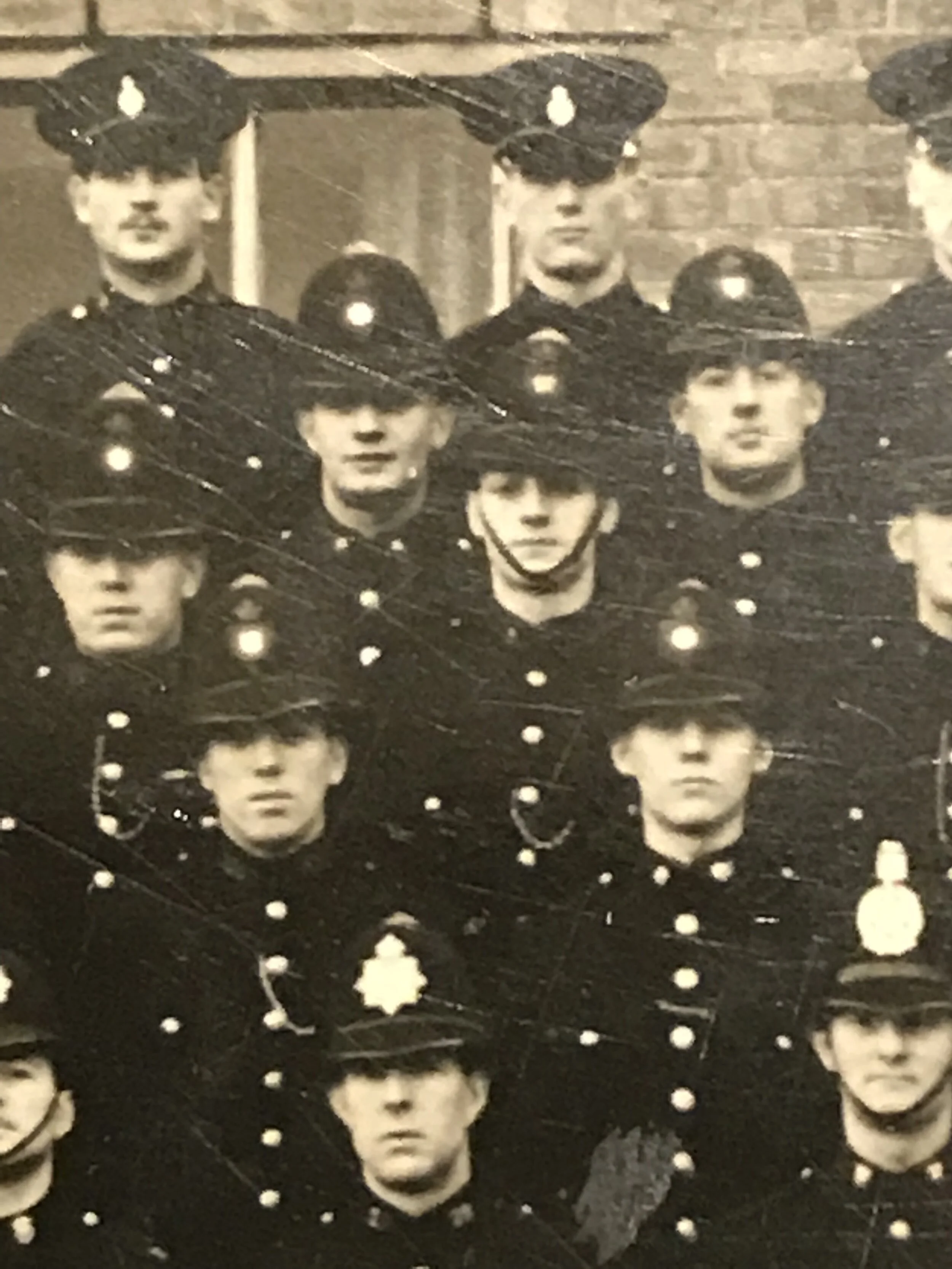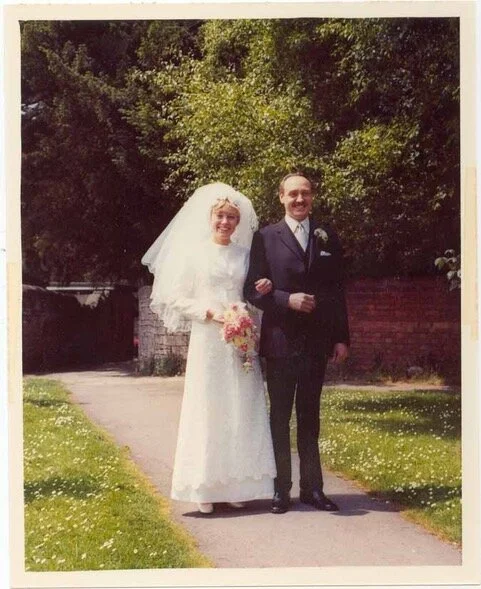WßD Part 2 Chapter Three Homeward Bound by Desmond B Webb

Windsor Street Days
Part 2
Chapter Three
Homeward Bound
by
Desmond Budd Webb
Part I
MY LAST CHAPTER ended with my transfer to a Wartime Reserved Occupation. Much was learned during the next two years but then, quite naturally for some, I became restless. My brother, Kenneth, was at this time in the United States of America, training to become a pilot. It was whilst he was there that on the 7th December 1941, that the Japanese suddenly attacked Pearl Harbour, which brought America into the war. Then, at last, news that my brother had qualified as a pilot and was homeward-bound by troop-ship.
Shortly after this I remember the thrill of my brother’s return and I vividly remember the family going to meet him off the train upon his arrival at Cheltenham.
*
As the train was slowly brought to a halt and doors opened, anxious eyes from the Webb family scanned the platform, when, almost simultaneously, the image that was eagerly sought appeared from an open door!
My brother Kenneth in the centre with two friends on the day they qualified as pilots at Craig Field Alabama, USA, April 24, 1942. I know that my brother was especially proud, as indeed were all pilots who qualified in the USA, to wear the USAAC Wings with the RAF Wings. Decades later, these were found amongst Arthur’s papers (Bette’s husband and my eldest brother) following Bette’s death, and which my son Ken has on display. I often wonder about this photograph. Three happy young men … I have often wondered whether Ken’s friends survived or whether, they too, are part of the 55,573 lost in Bomber Command in what became known as the Strategic Air Offensive, the air Battle of the Ruhr and the air Battle of Berlin respectively. Such is the price of one man’s megalomania. Always be on guard. DBW
Not to be outdone in the race to welcome home her newly acquired brother-in-law I remember Bette, upon spotting him, rushing up the platform to warmly embrace the figure of the person who has become the pride of the family. As I, likewise, made my approach to greet him, I pondered the reason for the obvious red mark that scarred the side of Ken’s face! Fears of any permanency were quickly removed when it became clear that it was only the result of Bette’s amorous welcome.
My sister-in-law Bette Webb 1941
Such was the thrill of this homecoming, that the family were united in their love, cherished by the bonding that unites and manifests itself so clearly by the family spirit.
And as I later told my son Ken, I will never forget that moment, the sound of his Aunt’s high heels clackety-clacking across the platform - I was mesmerised. We may be at war, Cheltenham had been bombed, but this didn’t stop Bette from having this portrait taken in the same month we were bombed … and I agree with Ken, it was my sister-in-law’s way of expressing her open defiance of tyranny. Bette was quite a firebrand.
Wedding of Athur H J Webb and Bette Florence Emily Webb neé Ford August 30 1941
(From Left to Right: Desmond Budd Webb (14) Groom’s youngest brother, Mrs Isabel Alice Webb (53) Groom’s Mother, Mr Horace A J Webb (54) Groom’s Father, Arthur’s Best Man, Mr Arthur H J Webb The Groom (26) Mrs Florence Emily - Bette - Webb The Bride Mrs Ford (Mother) Mr Ford (Father), Miss Patricia Ford (later Freeman) and future Lady Mayoress of Cheltenham. The author has not yet been able to establish the little child’s full name
Life is good …
*
L.eading Aircraftman (L.A.C) Kenneth E Webb Royal Air Force, Pilot’s Diploma April 24 1942 United States Army
After a short spell of home leave my brother was posted to an operational training Squadron, at Royal Air Force (RAF) Honeybourne, on the borders of Gloucestershire, where he was flying Whitley bombers. One day, whilst still working on the railway in the Cheltenham clerks’ office, someone drew the attention of other members of the staff to an aeroplane which appeared to be circling around the town and mimicking a dive bomb attack. I dared not mention that I suspected that it was my brother, who had mentioned to me that he may have the opportunity to do so as the airfield was only 20 miles away as the crow flies.
A few days afterwards this was confirmed when Ken, together with another member of the crew visited home and stayed overnight. On the occasion referred to, Ken and his crew had spent some time over Cheltenham, which they were entitled to do in simulating an attack upon an ‘enemy’ town, but all was not so readily appreciated by the townsfolk, including a neighbour of mine then home, who vehemently complained and ridiculed the audacity of the pilot who had the temerity to fly so low over the rooftops, the length of Windsor Street, where only a few years back he had grown up, and virtually new everyone in the ‘street’.
Orthographic Drawing of the Armstrong Whitworth Whitley (my thanks to RWM)
The Armstrong Whitworth Whitley twin engine bomber. My brother Ken flew these from RAF Honeybourne, Gloucestershire, operationally ,firstly in Leaflet Raids over Occupied Europe, and then as part of RAF Coastal Command from RAF St Eval, Cornwall on the U-Boat Hunter Killer Patrols during Nazi Germany’s attempted blockade of the British Isles to all convoys from Canada and the United States, before transferring to the mighty Handley-Page Halifax four engined bomber Mark V in 1943.
No one knew, but could only suspect, that within a very short time Kenneth and his crew, along with thousands more were to sacrifice their young lives for the benefit and saviour of mankind in their efforts to wrench the world from the evil instigated by Hitler's Germany and cruel anti-domestic policy that created the Holocaust.
Part II
Three archive films courtesy of the Imperial War Museum (IWM) and of YouTube
Note by Kenneth Thomas Webb
This 2.07 minute clip circa 1943-1944 shows the Handley Page Halifax Mk V flying in formation. And I am sincerely grateful to YouTube and to the correspondent whose e-mail appears at the end of the clip. I post this here as a fitting tribute to both my father’s brother Sergeant- Pilot 1315766 Kenneth Ernest Webb RAF VR and all the members of the Webb Crew DK165 MP-E and also to my mother’s brother Flight Sergeant 1337884 Harry Alfred Marshall, Pathfinder RAF VR (seconded to the RCAF) who, before his transfer to 405 City of Vancouver Pathfinder Squadron RCAF also flew many ops on Halifaxes; and to all the members of the Payne Crew Avro Lancaster PB402 LQ-M, he being the Payne Crew’s Flight Engineer.
© KTW © IBM
In this second clip, we catch a glimpse of the Armstrong Whitworth Whitley - also known as the flying pencil as it flew nose heavy, and which is clearly seen when the first film shows the aircraft on a test flight before it had been signed back into the charge of the Royal Air Force, as it makes a landing approach. I recall my father talking about this, and quoting Ken as saying how the aircraft flew nose-heavy. What surprises me is actually how large the Whitley is.
This first clip - 20 minutes - shows a Whitley being repaired in 1940, and is a marvellous study of civilian life, of the role of women in the war effort, of an island people and of a nation - the British People - very much at war. Keep in mind that this is at the height of the Battle of Britain.
© KTW © IBM
This second clip is just 3 minutes - and this time we see a squadron of Whitleys preparing to taxi; a pilot in full kit walking out to his aircraft, and again, the size of these planes is striking, given that they were only twin-engined.
© KTW © IBM
My Father Continues …
Early in 1944 I had become well established in my new duties, which were designed to equip me for suitability as a prospective locomotive engine driver, and I had accepted my fate that I would not follow my brother into the Royal Air Force, having, regrettably, failed an educational qualification, resulting from a four day stay in London where I had been called in consequence of my voluntary registration.
This four-day course arose four weeks after my brother was reported missing and the selection board took a sympathetic view, lessening the blow of my failure to pass by recommending that I return home and join the Air Training Corps where I could be trained in mathematics in order to retake the examination upon reaching the age of compulsory call-up at 18 years of age.
"With your brother missing, for which we are deeply sorry to hear, your mother will be pleased to have you at home at this particular time" was the added commentary to me.
The events which followed, and turning point in the war situation leading up to the invasion and the liberation of Europe, led to my current occupation being listed as a ‘reserve occupation’ resulting in an exemption from military service.
I recall the experiences attained on the footplate when many lads of my age longed to be given the privilege of stoking the fires which created the steam power to drive the massive trains.
Many of the fireboxes were some 12 to 14 feet long (3.65m to 4.26m), amongst which were engines shipped over from Canada in preparation for D-Day and would be used to convey heavy military equipment to the sites in readiness for the expected invasion of Europe. The trains of that period were swarmed with American troops and other Nations’ representatives. Many Americans would generously give the footplate men chewing gum and chocolates which they seemed to have in abundance, contrary to the less fortunate British soldier, sailor or airman.
*
I know that my mother (Isabel) cherished the presence of her only remaining son at home, but this was not easily accepted by me, who felt somewhat "out of things" as my close friends had all gone into the services. I worked long hours and I recall vividly, long periods held up in railway sidings outside Birmingham, when air raid sirens had alerted the population to a possible air raid.
At one stage, after the termination of the war in 1945, I rebelled against the retaining of my employment, listening intently but discontentedly to the rumours that the end of the steam engine was in sight and, therefore, the glamour associated with it.
So, on one occasion, when I had been placed in a siding just outside Cheltenham, when the train was scheduled to return to Gloucester, I took the opportunity to abscond from the train, ignoring the emphatic discountenance of my driver’s calls for me to return.
Hence, I was fined a week’s pay and incurred a further episode of a fine before I voluntarily left this employment as soon as the National Employment Emergency War Regulations were rescinded in 1947.
My repatriation to join my own friends in their own return to "civvy street" was about to begin and with it an ‘all new’ set of circumstances that was to beset the pattern of a still youthful life.
*
… at last the hour … Victory in Europe is announced by Winston Churchill 3pm May 8 1945
Victory in Europe - King George VI and Queen Elizabeth with Their Royal Highnesses the Princess Elizabeth and the Princess Margaet - Buckingham Palace - with the prime minister Winston Churchill May 8 1945
by
Desmond B Webb
Windsor Street - Pittville - Bishops Cleeve - Bredons Hardwick - Toddington - Brambridge
***
I CANNOT emphasise how proud I am to be able to publish here my father’s own manuscript. It is as if he sits here next to me, no not that, that one … and so forth. I wondered what to call this chapter, and looking at my father’s script, my eye captured that moment on the platform at the Cheltenham Railway Station. I knew, from a lifetime of family conversations, just what it meant to Des, to know that his brother had qualified as a pilot, and was, at last, on board ship home. That journey was not without danger, for this was at the height of the Battle of the Atlantic and Nazi Germany’s attempt to starve the British People into submission, and if readers ever visit Liverpool, the War Rooms deep underground have been preserved, for it is from there that the Battle of the Atlantic was fought.
After retiring from the police force, Des took up painting. Some of his paintings are with the family, the remainder of the collection - vast - I have here, safely stored, and I display them on a rotation basis. But one that stays out is my father’s copy, in waterclour, of a famous painting of three aircraft returning. I remember when I first saw it, blimey Dad… you’ve got all the movement; you can ‘feel’ the pilot at the controls as he edges her in towards the runway, grappling against the side wind and the pull on the underecarriage; and the two behind, exactly the same, the movement, that sense of moment, anxiety even, when the crews hope their undercarriages will safely lower. No one knows the extent of battle damage. And on the ground, life going on, work to be done, but the tension caught in the moment with the dog bouncing about in excitement. The noise of those engines so low would have been terrific, not to mention the down-draught.
Dad was quite pleased, I think. He had a certain way of smiling when being complimented that I think only my sisters and I (and our mother) would understand.
When Chapter Three closed, I suddenly realised that I needed an opening image. I looked at its title and only then … The three coming in on final aproach!
This is one of the joys of writing, not unlike the artist’s brush and use of colour, ‘that finishing touch’. It is akin to a perfect dovetailing.
Merely for the family’s interest, here are the RAF and USAAF wings we see on the tunic. The RAF wings denote the King’s Crown - George VI - and the Parker fountain pen was used by Isabel to annotate the photograph “‘Sgt Kenneth E. Webb Alabama U.S.A. Age 20 years.’ These artefacts are normally displayed behind glass to preserve them, and out of sunlight.
A Pilot walks out to his Armstrong Whitworth Whitley on a Royal Air Force station somewhere in England, the ground crew awaiting … (a still from the short 1940 clip above)
The Navigator seated behind the Pilot and Skipper in an Armstrong Whitworth Whitley twin engined Bomber 1940 (a still from the short 1940 clip above)
The Armstrong Whitworth Whitley - final checks, members of ground crew await the pilot’s all clear, the engines are running … those final moments before that international gesture of hands crossing the chest signalling “remove chocks please” … swift activity as the chocks are piulled from the wheels, the revo counters denote the change in engine tone … the aircraft begins its taxi to the runway …the navigator peers over the shoulder of his Skipper and Captain (a still from the short 1940 clip above)
16 June 2025
All Rights Reserved
© 2025 Kenneth Thomas Webb
Chapter Four ~ Post War
First written 25 May 2020
Ken Webb is a writer and proofreader. His website, kennwebb.com, showcases his work as a writer, blogger and podcaster, resting on his successive careers as a police officer, progressing to a junior lawyer in succession and trusts as a Fellow of the Institute of Legal Executives, a retired officer with the Royal Air Force Volunteer Reserve, and latterly, for three years, the owner and editor of two lifestyle magazines in Liverpool.
He also just handed over a successful two year chairmanship in Gloucestershire with Cheltenham Regency Probus.
Pandemic aside, he spends his time equally between his city, Liverpool, and the county of his birth, Gloucestershire.
In this fast-paced present age, proof-reading is essential. And this skill also occasionally leads to copy-editing writers’ manuscripts for submission to publishers and also student and post graduate dissertations.



















